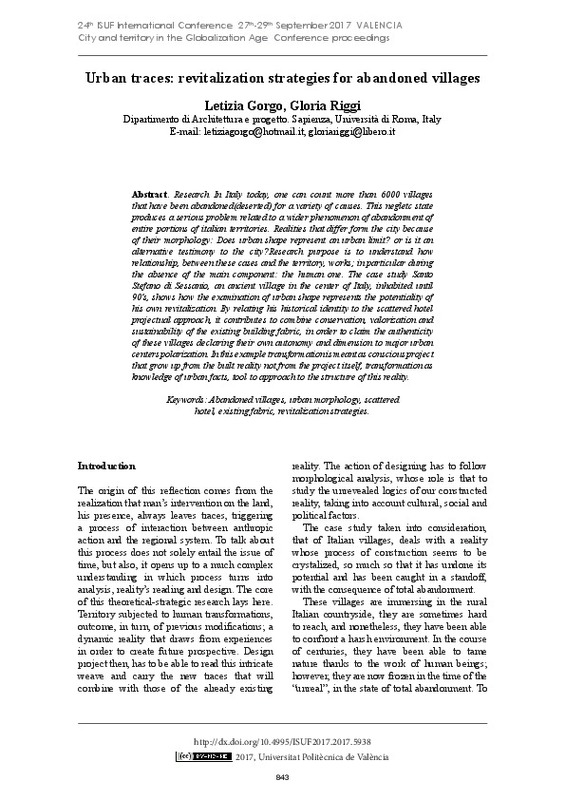JavaScript is disabled for your browser. Some features of this site may not work without it.
Buscar en RiuNet
Listar
Mi cuenta
Estadísticas
Ayuda RiuNet
Admin. UPV
URBAN TRACES: revitalization strategies for abandoned villages
Mostrar el registro sencillo del ítem
Ficheros en el ítem
| dc.contributor.author | Gorgo, Letizia
|
es_ES |
| dc.contributor.author | Riggi, Gloria
|
es_ES |
| dc.coverage.spatial | east=13.64567599999998; north=42.3442912; name= Santo Stefano di Sessanio AQ, Itàlia | es_ES |
| dc.date.accessioned | 2018-12-13T08:33:25Z | |
| dc.date.available | 2018-12-13T08:33:25Z | |
| dc.date.issued | 2018-04-20 | |
| dc.identifier.isbn | 9788490485743 | |
| dc.identifier.uri | http://hdl.handle.net/10251/113705 | |
| dc.description.abstract | [EN] Research In Italy today, one can count more than 6000 villages that have been abandoned(deserted) for a variety of causes. This negletc state produces a serious problem related to a wider phenomenon of abandonment of entire portions of italian territories. Realities that differ form the city because of their morphology: Does urban shape represent an urban limit? or is it an alternative testimony to the city?Research purpose is to understand how relationship, between these cases and the territory, works; in particular during the absence of the main component: the human one. The case study Santo Stefano di Sessanio, an ancient village in the center of Italy, inhabited until 90’s, shows how the examination of urban shape represents the potentiality of his own revitalization. By relating his historical identity to the scattered hotel projectual approach, it contributes to combine conservation, valorization and sustainability of the existing building fabric, in order to claim the authenticity of these villages declaring their own autonomy and dimension to major urban centers polarization. In this example transformation is meant as conscious project that grow up from the built reality not from the project itself, transformation as knowledge of urban facts, tool to approach to the structure of this reality | es_ES |
| dc.format.extent | 7 | es_ES |
| dc.language | Inglés | es_ES |
| dc.publisher | Editorial Universitat Politècnica de València | es_ES |
| dc.relation.ispartof | 24th ISUF International Conference. Book of Papers | es_ES |
| dc.rights | Reconocimiento - No comercial - Sin obra derivada (by-nc-nd) | es_ES |
| dc.subject | Abandoned villages | es_ES |
| dc.subject | Urban morphology | es_ES |
| dc.subject | Scattered hotel | es_ES |
| dc.subject | Existing fabric | es_ES |
| dc.subject | Revitalization strategies | es_ES |
| dc.title | URBAN TRACES: revitalization strategies for abandoned villages | es_ES |
| dc.type | Capítulo de libro | es_ES |
| dc.type | Comunicación en congreso | es_ES |
| dc.identifier.doi | 10.4995/ISUF2017.2017.5938 | |
| dc.rights.accessRights | Abierto | es_ES |
| dc.description.bibliographicCitation | Gorgo, L.; Riggi, G. (2018). URBAN TRACES: revitalization strategies for abandoned villages. En 24th ISUF International Conference. Book of Papers. Editorial Universitat Politècnica de València. 843-859. https://doi.org/10.4995/ISUF2017.2017.5938 | es_ES |
| dc.description.accrualMethod | OCS | es_ES |
| dc.relation.conferencename | 24th ISUF 2017 - City and Territory in the Globalization Age | es_ES |
| dc.relation.conferencedate | Septiembre 27-29,2017 | es_ES |
| dc.relation.conferenceplace | Valencia, Spain | es_ES |
| dc.relation.publisherversion | http://ocs.editorial.upv.es/index.php/ISUF/ISUF2017/paper/view/5938 | es_ES |
| dc.description.upvformatpinicio | 843 | es_ES |
| dc.description.upvformatpfin | 859 | es_ES |
| dc.type.version | info:eu-repo/semantics/publishedVersion | es_ES |
| dc.relation.pasarela | OCS\5938 | es_ES |








